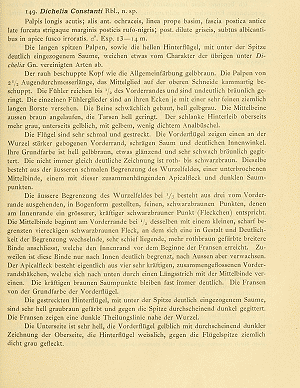

 +1Kontinente:EU
+1Kontinente:EU2. Diagnose
2.1. Erstbeschreibung
3. Biologie
3.1. Nahrung der Raupe
- [Solanaceae:] Datura stramonium ?? (Stechapfel ??)
Die Raupe für den Holotypus soll auf Teneriffa an Datura stramonium gefunden worden sein. Rebel (1894: 86) formuliert das aber recht vorsichtig. Große Zweifel daran sind angebracht.
Auch Kennel (1910: 116) formulierte vorsichtig: "Die Raupe lebt (nach dem Sammler der Art Sennor Cabrera) auf Datura stramonium". Weitere Funde der Raupe scheint es bisher nicht gegeben zu haben - theoretisch könnte sie also auch polyphag sein.
(Autor: Erwin Rennwald)
4. Weitere Informationen
4.1. Andere Kombinationen
- Dichelia constanti Rebel, 1894 [Originalkombination]
- Epagoge constanti (Rebel, 1894)
- Hastula constanti (Rebel, 1894)
- Avaria constanti (Rebel, 1894) [so bis Falck et al. (2022)]
4.2. Taxonomie
Dia als "Dichelia constanti" beschriebene Art ist seit ihrer Erstbeschreibung durch verschiedene Gattungen gewandert. Falck et al. (2022: 107) überführen sie in die Gattung Lopharcha und damit (wieder) in die Sektion Polyorthini der Unterfamilie Chlidanotinae.
Falck et al. (2022: 110) schreiben zu Lopharcha constanti weiterhin: "We are not able to decide whether the genus Lopharcha consists of one or three species from the Canary Islands. It was not possible for us to study the holotypes of L. gomeriana and L. palmariana, described from a single male and a single female respectively. Due to the lack of additional specimens from La Gomera and La Palma we hesitate to synonymize these species. However, we did not observe any morphological differences in the females between the populations from Tenerife / Gran Canaria, La Gomera and La Palma."
4.3. Faunistik
Locus typicus ist Laguna auf Teneriffa (Kanarische Inseln).Nach Falck et al. (2022: 109): "present in Tenerife and Gran Canaria".
(Autor: Erwin Rennwald)
4.4. Literatur
- Falck, P., Aarvik, L. & A. Vives Moreno (2022): New data on Old World Polyorthini. The genus Lopharcha Diakonoff, 1941 recorded from the Canary Islands (Spain) and Tanzania (Lepidoptera: Tortricidae). — SHILAP Revista de lepidopterología, 50 (197): 105-114. [PDF auf redalyc.org]
- Kennel, J. (1908-1921): Die Palaearktischen Tortriciden. Eine monographische Darstellung. — Zoologica, 21 (54): 1-546. [PDF auf zobodat.at]
- Erstbeschreibung: Rebel, H. & A. Rogenhofer (1894): Zur Lepidopterenfauna der Canaren. — Annalen des k. k. naturhistorischen Hofmuseums 9 (1): 1-96, pl. I. [PDF auf zobodat.at]





